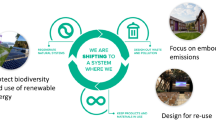Abstract
The transition from a linear to a circular economy is a process that has already started throughout our societies as one important strategy to reduce CO2 emissions and by decoupling the use of natural resources, materials and fossil fuels from economic activity. Using examples from the Construction Industry, this paper argues that key premises must be present for circularity to happen. The business case at each level of the value circle must be viable. New building standards backed up by adequate policy measures, e.g. green public procurement, CO2 and virgin materials taxation is likely to be required. Finally, securing future supply of secondary raw materials (SRM) must be demonstrated and adequate supply chains of SRM to emerge.
Access this chapter
Tax calculation will be finalised at checkout
Purchases are for personal use only
Similar content being viewed by others
Notes
- 1.
Interreg NWE project: ‘By-products for sustainable concrete in the urban environment’, www.nweurope.eu/urbcon.
- 2.
Marie Curie PhD training network, http://www.dursaam.ugent.be.
- 3.
Horizon2020 project: Geopolymer technology for the development of mineral wool waste value chains. https://www.wool2loop.eu/en/.
- 4.
The European Recycling Industries Confederation.
- 5.
According to the Wool2Loop project.
- 6.
According to industrial partners in Wool2Loop and URBCON.
- 7.
Based on internal communication within Wool2Loop project.
- 8.
According to industrial partners in Urbcon project.
References
UN: Global Status Report, 2017. https://www.worldgbc.org/news-media/global-status-report-2017. Last accessed 2019/12/20
Lehne J, Preston F (2018) Making Concrete Change. Innovation in Low-Carbon Cement and Concrete. The Royal Institute of International Affairs (UK), Chatham House
Habert, G., Ouellet-Plamondon, G.: Recent update on the environmental impact of geopolymers. RILEM Techn. Lett. 1 (2016)
BIO Intelligence Service: Sectoral resource maps. European Commission, Prepared in response to an Information Hub request (2013)
Gartner, E.: Industrially interesting approaches to “low-CO2” cements. Cem. Concr. Res. 34(9), 1489–1498 (2004)
Turner, L.K., Collins, F.G.: Carbon dioxide equivalent (CO2-e) emissions: a comparison between geopolymer and OPC cement concrete. Constr. Build. Mater. 43, 125–130 (2013)
Eurostat: Waste Generation (2016). https://ec.europa.eu/eurostat/statistics-explained/index.php/Waste_statistics. Last accessed 2019/12/19
European Commission: EU Construction and Demolition Waste Protocol and Guidelines. https://ec.europa.eu/growth/content/eu-construction-and-demolition-waste-protocol-0_en. Last accessed 2019/12/20
Meyer, C.: The greening of the concrete industry. Cement Concr. Compos. 31(8), 601–605 (2009)
Duxson, P., Van Deventer, J.S.J.: 17—Commercialization of geopolymers for construction—opportunities and obstacles. In: Provis, J.L., van Deventer, J.S.J. (eds.) Geopolymers. Woodhead Publishing, pp 379–400 (2009)
Väntsi, O., Kärki, T.: Mineral wool waste in Europe: a review of mineral wool waste quantity, quality, and current recycling methods. J. Mater. Cycles Waste Manage. 16(1), 62–72 (2014)
Feuerborn, H.-J.: Coal combustion products in Europe–an update on production and utilization, standardisation and regulation. In: World Coal Ash Conference (2011)
Lloyd, N., Rangan, V.: Geopolymer concrete with fly ash. In: Proceedings of the Second International Conference on Sustainable Construction Materials and Technologies, UWM Center for By-Products Utilization (2010)
EUROSLAG: Statistics 2016—Euroslag. https://www.euroslag.com/products/statistics/statistics-2016/. Last accessed 2019/12/06
Coppola, L., Buoso, A., Coffetti, D., Kara, P., Lorenzi, S.: Electric arc furnace granulated slag for sustainable concrete. Constr. Build. Mater. 123, 115–119 (2016)
Habert, G., De. Lacaillerie, J.D.E., Roussel, N.: An environmental evaluation of geopolymer based concrete production: reviewing current research trends. J. Clean. Prod. 19(11), 1229–1238 (2011)
Kamseu, E., Moungam, L.M., Cannio, M., Bilong, N., Chaysuwan, D., Melo, U.C., Leonelli, C.: Substitution of sodium silicate with rice husk ash-NaOH solution in metakaolin based geopolymer cement concerning reduction in global warming. J. Clean. Prod. 142, 3050–3060 (2017)
Puertas, F.,Torres-Carrasco, M.: Use of glass waste as an activator in the preparation of alkali-activated slag. Mechanical strength and paste characterisation. Cem. Concr. Res. 57:95–104 (2014)
Acknowledgements
Thanks to the projects Wool2Loop and URBCON and all partners in contributing with knowledge, insights as well as hard and soft data.
Author information
Authors and Affiliations
Corresponding author
Editor information
Editors and Affiliations
Rights and permissions
Copyright information
© 2021 The Author(s), under exclusive license to Springer Nature Switzerland AG
About this paper
Cite this paper
Andersen, B.H., Salvetti, G., Komkova, A. (2021). Circular Economic Modelling—Barriers and Challenges Throughout the Value Circle. In: M.C.F. Cunha, V., Rezazadeh, M., Gowda, C. (eds) Proceedings of the 3rd RILEM Spring Convention and Conference (RSCC 2020). RSCC 2020. RILEM Bookseries, vol 35. Springer, Cham. https://doi.org/10.1007/978-3-030-76543-9_12
Download citation
DOI: https://doi.org/10.1007/978-3-030-76543-9_12
Published:
Publisher Name: Springer, Cham
Print ISBN: 978-3-030-76542-2
Online ISBN: 978-3-030-76543-9
eBook Packages: EngineeringEngineering (R0)




